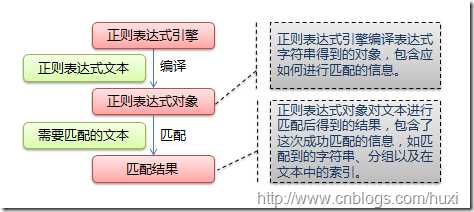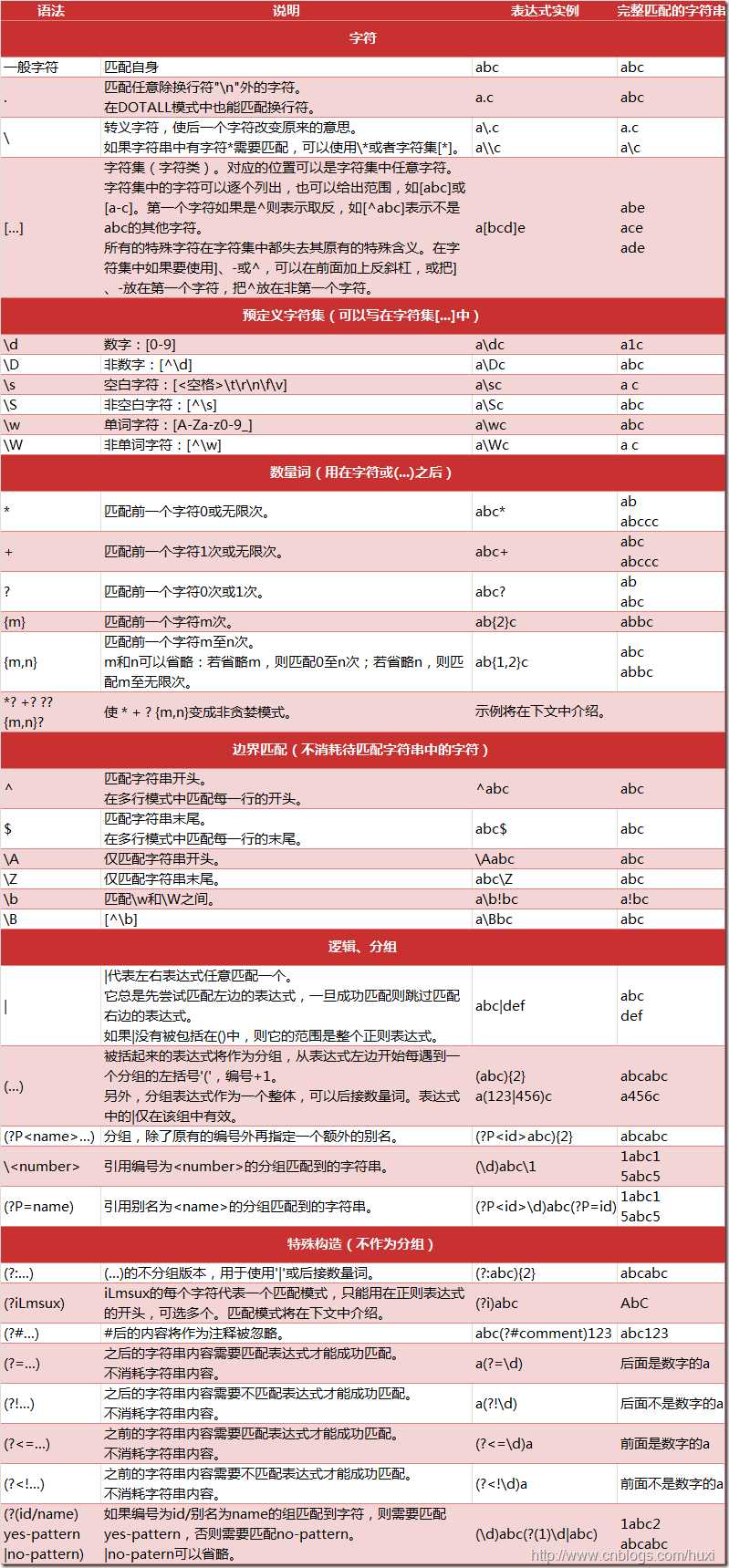标签:
正则表达式并不是Python的一部分。正则表达式是用于处理字符串的强大工具,拥有自己独特的语法以及一个独立的处理引擎,效率上可能不如str自带的方法,但功能十分强大。得益于这一点,在提供了正则表达式的语言里,正则表达式的语法都是一样的,区别只在于不同的编程语言实现支持的语法数量不同;但不用担心,不被支持的语法通常是不常用的部分。如果已经在其他语言里使用过正则表达式,只需要简单看一看就可以上手了。
下图展示了使用正则表达式进行匹配的流程: 
正则表达式的大致匹配过程是:依次拿出表达式和文本中的字符比较,如果每一个字符都能匹配,则匹配成功;一旦有匹配不成功的字符则匹配失败。如果表达式中有量词或边界,这个过程会稍微有一些不同,但也是很好理解的,看下图中的示例以及自己多使用几次就能明白。
下图列出了Python支持的正则表达式元字符和语法: 
正则表达式通常用于在文本中查找匹配的字符串。Python里数量词默认是贪婪的(在少数语言里也可能是默认非贪婪),总是尝试匹配尽可能多的字符;非贪婪的则相反,总是尝试匹配尽可能少的字符。例如:正则表达式"ab*"如果用于查找"abbbc",将找到"abbb"。而如果使用非贪婪的数量词"ab*?",将找到"a"。
与大多数编程语言相同,正则表达式里使用"\"作为转义字符,这就可能造成反斜杠困扰。假如你需要匹配文本中的字符"\",那么使用编程语言表示的正则表达式里将需要4个反斜杠"\\\\":前两个和后两个分别用于在编程语言里转义成反斜杠,转换成两个反斜杠后再在正则表达式里转义成一个反斜杠。Python里的原生字符串很好地解决了这个问题,这个例子中的正则表达式可以使用r"\\"表示。同样,匹配一个数字的"\\d"可以写成r"\d"。有了原生字符串,你再也不用担心是不是漏写了反斜杠,写出来的表达式也更直观。
正则表达式提供了一些可用的匹配模式,比如忽略大小写、多行匹配等,这部分内容将在Pattern类的工厂方法re.compile(pattern[, flags])中一起介绍。
Python通过re模块提供对正则表达式的支持。使用re的一般步骤是先将正则表达式的字符串形式编译为Pattern实例,然后使用Pattern实例处理文本并获得匹配结果(一个Match实例),最后使用Match实例获得信息,进行其他的操作。
|
1
2
3
4
5
6
7
8
9
10
11
12
13
14
15
|
# encoding: UTF-8import re# 将正则表达式编译成Pattern对象pattern = re.compile(r‘hello‘)# 使用Pattern匹配文本,获得匹配结果,无法匹配时将返回Nonematch = pattern.match(‘hello world!‘)if match: # 使用Match获得分组信息 print match.group()### 输出 #### hello |
re.compile(strPattern[, flag]):
这个方法是Pattern类的工厂方法,用于将字符串形式的正则表达式编译为Pattern对象。 第二个参数flag是匹配模式,取值可以使用按位或运算符‘|‘表示同时生效,比如re.I | re.M。另外,你也可以在regex字符串中指定模式,比如re.compile(‘pattern‘, re.I | re.M)与re.compile(‘(?im)pattern‘)是等价的。 可选值有:
|
1
2
3
4
|
a = re.compile(r"""\d + # the integral part \. # the decimal point \d * # some fractional digits""", re.X)b = re.compile(r"\d+\.\d*") |
re提供了众多模块方法用于完成正则表达式的功能。这些方法可以使用Pattern实例的相应方法替代,唯一的好处是少写一行re.compile()代码,但同时也无法复用编译后的Pattern对象。这些方法将在Pattern类的实例方法部分一起介绍。如上面这个例子可以简写为:
|
1
2
|
m = re.match(r‘hello‘, ‘hello world!‘)print m.group() |
re模块还提供了一个方法escape(string),用于将string中的正则表达式元字符如*/+/?等之前加上转义符再返回,在需要大量匹配元字符时有那么一点用。
Match对象是一次匹配的结果,包含了很多关于此次匹配的信息,可以使用Match提供的可读属性或方法来获取这些信息。
属性:
方法:
|
1
2
3
4
5
6
7
8
9
10
11
12
13
14
15
16
17
18
19
20
21
22
23
24
25
26
27
28
29
30
31
32
|
import rem = re.match(r‘(\w+) (\w+)(?P<sign>.*)‘, ‘hello world!‘)print "m.string:", m.stringprint "m.re:", m.reprint "m.pos:", m.posprint "m.endpos:", m.endposprint "m.lastindex:", m.lastindexprint "m.lastgroup:", m.lastgroupprint "m.group(1,2):", m.group(1, 2)print "m.groups():", m.groups()print "m.groupdict():", m.groupdict()print "m.start(2):", m.start(2)print "m.end(2):", m.end(2)print "m.span(2):", m.span(2)print r"m.expand(r‘\2 \1\3‘):", m.expand(r‘\2 \1\3‘)### output #### m.string: hello world!# m.re: <_sre.SRE_Pattern object at 0x016E1A38># m.pos: 0# m.endpos: 12# m.lastindex: 3# m.lastgroup: sign# m.group(1,2): (‘hello‘, ‘world‘)# m.groups(): (‘hello‘, ‘world‘, ‘!‘)# m.groupdict(): {‘sign‘: ‘!‘}# m.start(2): 6# m.end(2): 11# m.span(2): (6, 11)# m.expand(r‘\2 \1\3‘): world hello! |
Pattern对象是一个编译好的正则表达式,通过Pattern提供的一系列方法可以对文本进行匹配查找。
Pattern不能直接实例化,必须使用re.compile()进行构造。
Pattern提供了几个可读属性用于获取表达式的相关信息:
|
1
2
3
4
5
6
7
8
9
10
11
12
13
|
import rep = re.compile(r‘(\w+) (\w+)(?P<sign>.*)‘, re.DOTALL)print "p.pattern:", p.patternprint "p.flags:", p.flagsprint "p.groups:", p.groupsprint "p.groupindex:", p.groupindex### output #### p.pattern: (\w+) (\w+)(?P<sign>.*)# p.flags: 16# p.groups: 3# p.groupindex: {‘sign‘: 3} |
实例方法[ | re模块方法]:
|
1
2
3
4
5
6
7
8
9
10
11
12
13
14
15
16
|
# encoding: UTF-8 import re # 将正则表达式编译成Pattern对象 pattern = re.compile(r‘world‘) # 使用search()查找匹配的子串,不存在能匹配的子串时将返回None # 这个例子中使用match()无法成功匹配 match = pattern.search(‘hello world!‘) if match: # 使用Match获得分组信息 print match.group() ### 输出 ### # world |
|
1
2
3
4
5
6
7
|
import rep = re.compile(r‘\d+‘)print p.split(‘one1two2three3four4‘)### output #### [‘one‘, ‘two‘, ‘three‘, ‘four‘, ‘‘] |
|
1
2
3
4
5
6
7
|
import rep = re.compile(r‘\d+‘)print p.findall(‘one1two2three3four4‘)### output #### [‘1‘, ‘2‘, ‘3‘, ‘4‘] |
|
1
2
3
4
5
6
7
8
|
import rep = re.compile(r‘\d+‘)for m in p.finditer(‘one1two2three3four4‘): print m.group(),### output #### 1 2 3 4 |
|
1
2
3
4
5
6
7
8
9
10
11
12
13
14
15
|
import rep = re.compile(r‘(\w+) (\w+)‘)s = ‘i say, hello world!‘print p.sub(r‘\2 \1‘, s)def func(m): return m.group(1).title() + ‘ ‘ + m.group(2).title()print p.sub(func, s)### output #### say i, world hello!# I Say, Hello World! |
|
1
2
3
4
5
6
7
8
9
10
11
12
13
14
15
|
import rep = re.compile(r‘(\w+) (\w+)‘)s = ‘i say, hello world!‘print p.subn(r‘\2 \1‘, s)def func(m): return m.group(1).title() + ‘ ‘ + m.group(2).title()print p.subn(func, s)### output #### (‘say i, world hello!‘, 2)# (‘I Say, Hello World!‘, 2) |
以上就是Python对于正则表达式的支持。熟练掌握正则表达式是每一个程序员必须具备的技能,这年头没有不与字符串打交道的程序了。笔者也处于初级阶段,与君共勉,^_^
另外,图中的特殊构造部分没有举出例子,用到这些的正则表达式是具有一定难度的。有兴趣可以思考一下,如何匹配不是以abc开头的单词,^_^
标签:
原文地址:http://www.cnblogs.com/hushaojun/p/4746512.html